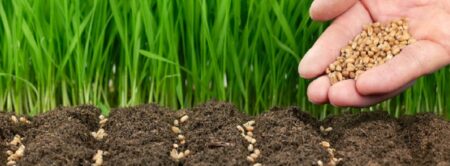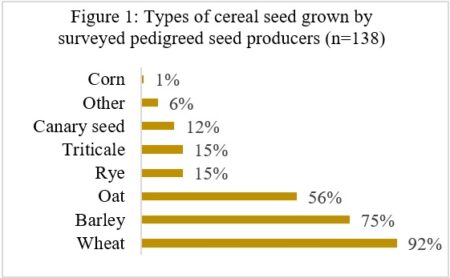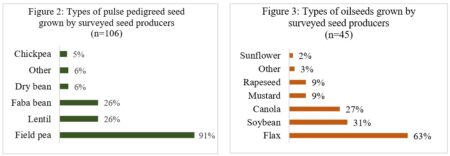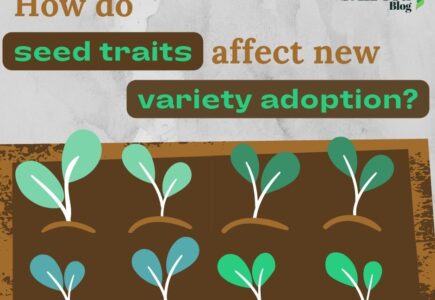The following uses results from an article published in the Canadian Journal of Plant Science, on February 9, 2023: Decision factors influencing new variety adoption in western Canada by the seed industry
Click here to read the original article by Dr. Lassoued and Dr. Smyth

Source: https://www.osscltd.in
With the growing world population and the dwindling of natural resources, there is continued urgency to enhance crop productivity in response to growing food demands and to the changing climate. Thus, substantive investments in research and development (R&D), particularly in support of new varieties with improved traits to replace older varieties is crucial.
In Canada, increasing breeding efforts over the years have led to improved varieties that meet the challenges of the marketplace and the production concerns of producers. Since the 1960s, over 7,000 different varieties of cereals, oilseeds and pulses have been registered by the Canadian Food Inspection Agency’s (CFIA) Variety Registration Office.
It might sound that Canadian seed growers have a plethora of options to choose from when deciding which variety(ies) to grow. However, not all registered varieties are being grown. For instance, wheat—Canada’s largest grown field crop—in Western Canada, is concentrated in a select few varieties. The low uptake of some new varieties by prairie seed growers means that not all newly developed varieties are successful. This raises the obvious question of what factors does the certified seed sector account for in the decision to adopt new varieties?
To answer this question, we conducted a study to provide insights into what factors shape the decision to produce a new crop variety for commercial seed sales in Canada. Our objective was to learn what level of agronomic and quality trait enhancement is required by the certified seed sector to adopt newly developed varieties. To do so, we surveyed seed growers and seed firms from Saskatchewan, Alberta and Manitoba between July 2021 and June 2022. This blog briefly answers the above question by summarizing key results recently published in the Canadian Journal of Plant Science.
Types of seed crops produced by prairie seed growers
In total, our sample of 155 seed producers included 17 seed firms and 138 seed growers. Thirty-two percent of those have been engaged in pedigreed seed production for 20 years or less, 34% between 20 to 40 years, and 34% for over 40 years. Surveyed seed growers produced mainly cereals (89%, n=138), pulses (68%, n=106), oilseeds (38%, n=59) and forages (22%, n=34). (As less than a quarter of the sample grow forages, we will not cover results associated with this crop type in the remainder of this blog.) Certified, registered and foundation seeds were the predominant seed classes for these four crop types.

Wheat (92%) was the most widely grown cereal type among surveyed seed producers, followed by barley (75%) and oat (56%) as illustrated in Figure 1. Of Canadian wheat varieties, 92% responded to producing Canada Western Red Spring (CWRS), while the next highest wheat classification was Canada Prairie Spring Red (CPSR) 36%.
As for surveyed pulse seed growers (n=106), they mostly produced field pea (91%), lentil (26%), and faba bean (26%). Dry beans and chickpeas were produced by less than 10% of the surveyed growers (Figure 2). The surveyed oilseed seed growers (n=59) produced mostly flax (67%), soybean (33%), and canola (24%). Less than 10% of them produce rapeseed, mustard, and sunflower (Figure 3). Suggesting that across the crop kinds for seed producers, there were preferences in crop types of pedigreed seed growers.

What traits matter for varietal adoption?
To better understand producers’ choice of seed variety, we asked about the importance of different agronomic traits in their decision to produce a newly developed seed variety. As displayed in Table 1, a ✓ means moderately important and ✓✓ was selected as highly important. For cereals, pulses and oilseeds, growers identified yield, disease and lodging resistance as highly important. Yield is the primary agronomic trait most surveyed seed producers identified as being the key factor of variety selection decisions across all crop types. This is not surprising as pedigreed seed growers are mainly paid for bushels per acre. Resistance to diseases and lodging were also chosen as critical. Lodging is the bending over of stems, which affects harvesting and crop health. Inadequate standing power of the crop combined with environmental conditions such as rain, wind or hail contributes to lodging, which can result in lower yields. Given the importance of yield, it’s not surprising that disease and lodging which impacts yield is important traits to a producer.
Pod shattering tolerance was highly important for pulse and oilseed growers. Shattering refers to the release of seeds upon maturation and prior to harvest, which also affects mechanical harvesting and can be a major cause of yield loss in crops. Like lodging, severe environmental conditions such as hailstorms and strong winds can increase yield losses caused by pod shattering. As such, reduced lodging and shattering increase yield as they contribute to harvest efficiencies (straight cutting). Herbicide tolerance is also highly important for most oilseed growers.

Other agronomic characteristics such as drought or frost tolerance, excessive moisture tolerance, insect resistance, plant height, and days to maturity have moderate to high importance for seed growers’ decision on which to select new varieties of cereals, pulses, and oilseeds. These traits affect the quality of the seed, generally reflected by vigour: the ability of the seed to germinate quickly, emerge, and establish healthy seedlings. For instance, harvesting at the proper time is a key factor in obtaining high vigour seeds. Early harvesting may result in immature seeds, while delayed harvest increases the potential damage from fall frost or excessive rain during seed pre-harvest processes. Thus, the number of days to maturity is important in growers’ decision to adopt a new variety.
Quality traits also matter when it comes to varietal adoption by prairie seed growers. For wheat varieties like CWRS and CPSR, malting and milling qualities, protein content, and test weight were all important for surveyed cereal seed producers. Additionally, growers needed high protein levels in pulses and high oil content in oilseeds to multiply a new seed variety of those crops.
Seed growers always seeking better overall variety performance
High seed quality is vital for pedigreed seed growers as it helps with important crop input decisions including the choice of the variety to grow. Overall, our survey results show that choosing a variety within a crop kind was mainly based on several agronomic considerations. Yield was the highest priority as it directly impacts seed growers’ net returns and their business viability. Other performance improvements such as disease resistance or quality attributes that impact yield may be just as important for achieving higher returns. Other agronomic traits were also important and depend on the crop type grown. Lodging tolerance and pod shattering reduction technology are critical for cereal, pulse and oilseed seed growers as they impact yield. High malting and milling features, high levels of protein and oil were significant traits for cereal, pulse and oilseed seed growers, respectively.
Trait enhancement in both agronomic and quality attributes motivate growers to multiply newer varieties. Surveyed seed growers demanded at least a 5% increase in yield, moderate improvements in disease resistance, and at least a 1% increase in protein and oil content as important factors in choosing new varieties. Most pedigree seed growers would like to see higher quality (purity and vigour) seed with better agronomic variety performance in their operation. The results of this survey illustrate the desirability of various traits, and may assist plant breeders in their decision to bring elite lines forward for variety registration.


